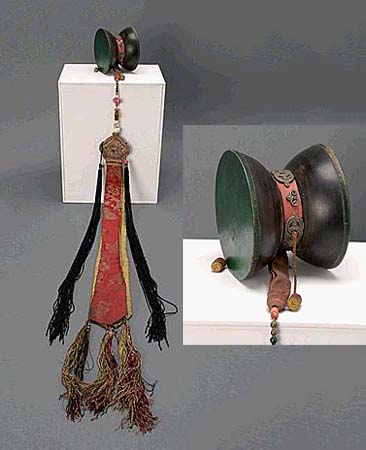
Owner: HWMC
Catalogue #: AS-MBST-04-14
Struck Membranophones
Tibet ‘Damaru’ (Gcod-dar)
Tibet
Tibetan Buddhist
Wood, silk, metal, beads
19th century
Drum diameter: 3 in; Length (incl. ribbons): 42 in
Membranophones – Struck Membranophones
This Tibetan Buddhist damaru is a small two-headed hourglass (waisted) pellet drum, known as a power drum, as it is believed to generate spiritual energy. The damaru is used in Hinduism and Tibetan Buddhism. In Hinduism, it is known as the instrument of the deity Shiva. It is said to be created by Shiva to produce spiritual sounds by which the whole universe has been created and regulated. In Tibetan Buddhism, the damaru is used as an instrument in tantric practices. This Tibetan damaru is used in the gcod rites and is called gcod-dar (‘gcod drum’). It is made of wood with both leather heads glued on and painted green. A ribbon with metal emblems is attached to the waist of the drum and supports two silk cords, each with a small ball at the end (pellets). It is played by holding the fabric handle in the right hand and shaking it sideways so that the balls strike each head alternately.
The damaru is used in Buddhist rituals together with a handbell (dril-bu) held in the left hand or with a bone trumpet (rkang-gling). Both of these instruments are also shown in this collection.
Resource: “Damaru,” Alastair Dick, Mirelle Helffer, “The Grove Dictionary of Musical Instruments,” 2nd ed., Vol 2, Laurence Libin, Editor in Chief, Oxford University Press
